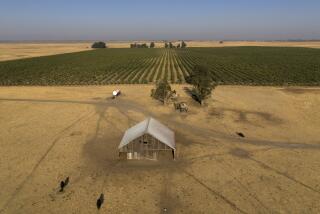Plan to Protect DWP’s Sierra Land Dies
A proposal to forever ban development of Eastern Sierra land owned by the Los Angeles Department of Water and Power has fallen apart, although the idea may survive in some other form.
The private Wildlands Conservancy, which was to put up half the money to buy a conservation easement for more than 300,000 acres of DWP land, informed department commissioners Friday that it was dropping out.
“We have decided a public policy issue of this great magnitude should be promoted by public officials and not a nonprofit organization,” conservancy Executive Director David Myers wrote in a letter. “Therefore, we formally withdraw our proposal.”
Under a plan drawn up by the Yucaipa-based group and DWP General Manager S. David Freeman, the department would have permanently relinquished its right to develop its Owens Valley land in exchange for $25 million from the Wildlands Conservancy and the state.
Though Owens Valley residents dearly cherish--and want to preserve--the uncluttered landscape maintained by the DWP for nearly a century, they greeted the proposal with suspicion.
That, coupled with opposition of some DWP commissioners and Los Angeles Mayor Richard Riordan, led the conservancy to pull out.
But it does not necessarily spell the end of efforts to protect the DWP’s empty stretch of the Eastern Sierra.
Freeman, who discussed the issue late last month at a meeting attended by hundreds of Inyo and Mono county residents, said he believed a protection plan involving more local control might be better received.
“I think the real question is whether this idea catches on in the Owens Valley. If it doesn’t, I think it dies. If it does, I think it will be pursued.”
The political climate is likely to change soon. Los Angeles city officials said Monday that Freeman will leave the DWP to assume a state energy post. Riordan will leave office this summer, and his successor will make his own appointments to the water and power board, perhaps creating more support for a conservation proposal.
Ralph Haber, president of a new Mono County-based conservancy group, said the protection proposal had stirred too much interest to evaporate without a trace. He added that his group, the Eastern Sierra Conservancy, probably would pursue it in some form.
At the citizens meeting in the Eastern Sierra town of Bishop, residents made it clear that they do not want their wind-swept desert valley to fill up with subdivisions and fast-food outlets.
But they expressed distrust of outside environmental groups and of the state.
Despite reassurances to the contrary, locals worried that a conservation agreement would cost them cattle grazing leases and recreational access to the DWP lands.
“For better or worse, the Wildlands Conservancy has been a kind of a lightning rod for a lot of the negative feeling,” Haber said.
Had the National Rifle Assn. or an off-road vehicle organization drafted a protection plan, he said, “there wouldn’t have been any opposition.”
Heidi Fron, staff attorney for the Wildlands Conservancy, agreed that “people are more focused on who is presenting the idea than the idea itself.”
By stepping aside, she said, her group may be able to redirect attention to the concept.
More to Read
Sign up for Essential California
The most important California stories and recommendations in your inbox every morning.
You may occasionally receive promotional content from the Los Angeles Times.











